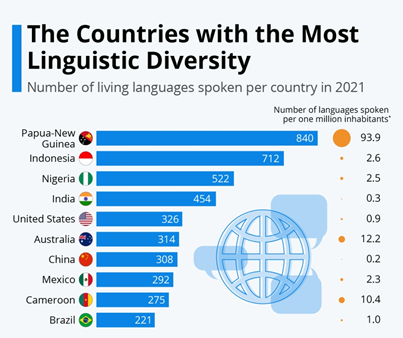

20th October 2022 (7 Topics)
Implementing Hindi and Other State language as a medium of Instruction can effect Multilingualism in India
Context
With the recent announcement regarding the adoption of Hindi and local languages as a medium of Instruction in Educational Institutions, it still remains a subject of debate as India is a country with many languages and ethnicity in a similar State.
Let us see, how this idea is difficult to flourish.
About
- Over 700 languages are spoken in India. However, India has no national language.
- As per the 8thschedule of Indian constitution, there are 22 scheduled or official languages that are given official acknowledgement and support.
- Article 343 of the Constitution of India stated that the official language of the Union is Hindi in Devanagari script, with official use of English to continue for 15 years from 1947.
- Later, a constitutional amendment, The Official Languages Act, 1963, allowed for the continuation of English alongside Hindi in the Indian government indefinitely until legislation decides to change it.
About
Key Highlights of the Committee’s Report on Languages:
- Under National Education Policy: The Ministry of Education in November 2021 constituted a high-powered committee, the Bharatiya Bhasha Samiti.
- The committee is tasked with preparing an action plan for the growth of Indian languages as prescribed under National Education Policy (NEP) 2020,
- It was required the mother tongue to be the medium of instruction in schools and higher education institutions.
- Committee recommendations on Report of 2021:
- The language used for communication in the administration should be Hindi, and efforts should be made to teach the curriculum in Hindi, but the latter is not mandatory.
- Lower courts in Uttar Pradesh, Uttarakhand, Madhya Pradesh, Bihar, Haryana, and Rajasthan already use Hindi.
- High Courts in other states, where proceedings are recorded in English or a regional language can make available translations in Hindi, because verdicts of High Court of other states are often cited in judgments.
- The panel wants state governments to warn officials that their reluctance to use Hindi would reflect in their Annual Performance Assessment Report (APAR).
How it impact the Multilingualism in India?
- Extinction of Other Ethnic Languages
|
Do you know? The idea of mother tongue is also a Western, Christian one. Ivan Illich in Vernacular Values notes that the word mother tongue came to India only in the 18th century via English and as an idea, mother tongue emerged as a territorial claim of the Abbey of Gorze (now in France) in the 11th century and is inseparable from the ideas of motherland, Mother Church and Mother Mary. |
- Barrier in single implementation
- Maintenance of adequate recruitment of Staff
- Can lead to Socio-cultural divide

Other Associated Challenges:
- Insignificant for Institutions with Pan-India Admissions: A regional language focus is not meaningful in a scenario where the institutes see entrants from across the country such as IITs.
- Availability of Quality Material in Regional Languages: Another challenge is the availability of study material such as textbooks and scholarly literature.
- Also, quality control of these translations will be of utmost importance to keep semantic irregularities at bay.
- Availability of Faculty:Given the English-medium legacy of higher education in India, attracting and retaining quality teachers who are willing and able to teach in regional languages will be a challenge.
- Maintaining Pace with Global Standards: Delivering technical courses in regional languages may prevent students from competing in global labour and education markets, where fluency in English yields a distinct edge.
- A lack of opportunities for Indian students at the international level may prove counterproductive to the NEP, 2020’s aim of bridging the gap between elites and the rest.
- It also goes against the vision of promoting the internationalization of education.
Recent Developments
- SWAYAM, an open online courses platform of the Central government, has been offering some popular courses in Indian languages too.
- Ten States have accepted Indian languages such as Hindi, Kannada, Tamil, Telugu, Marathi, and Bengali as the medium of instruction for engineering courses.
- National Education policy, 2020:
- To Increase GER to 50 % by 2035: NEP 2020 aims to increase the Gross Enrolment Ratio in higher education including vocational education from 26.3% (2018) to 50% by 2035. 3.5 Crore new seats will be added to Higher education institutions.
- Promoting Regional languages in higher education: NEP provides a framework for the education sector but is not binding on the States.
- Medical Education Minister of Madhya Pradesh has announced that the state government would soon launch MBBS course in Hindi medium.



